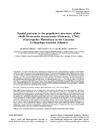Please use this identifier to cite or link to this item:
https://accedacris.ulpgc.es/jspui/handle/10553/886
| Title: | Spatial patterns in the population structure of the whelk Stramonita haemastoma (Linnaeus, 1766) (Gastropoda: muricidae) in the Canarian Archipielago (eastern Atlantic) | Other Titles: | Patrones espaciales en la estructura poblacional del caracol Stramonita haemastoma (Linnaeus, 1766) (Gastropoda: Muricidae) en el Archipiélago Canario (Atlántico oriental) | Authors: | Ramírez Cañada,Rubén Tuya, F. Haroun, Ricardo |
UNESCO Clasification: | 241705 Biología marina 240210 Biología de poblaciones 240119 Zoología marina |
Keywords: | Caracoles marinos Canarias Distribución vertical Animales marinos predadores Stramonita haemastoma, et al |
Issue Date: | 2009 | Journal: | Scientia Marina | Abstract: | The goal of this study was to determine the consistency of the vertical distribution patterns of the predatory whelk, Stramonita haemastoma, in the rocky intertidal zone of the Canarian Archipelago (eastern Atlantic) across a hierarchy of five orders of magnitude of horizontal spatial variability (from tens of m to hundreds of km). In general, this species showed a consistent vertical zonation pattern across islands, with the majority of the specimens (74.65%) found in the mid intertidal zone. This result most likely reflects the whelk’s preference for a habitat with a large amount of potential prey but minimal stress induced by swells and desiccation. The mean abundance (0 to 1.73 ± 0.40 ind m-2, mean ± SE) and size structure (7 to 45 mm in shell length) of S. haemastoma in the Canarian Archipelago was considerably lower compared to those from continental areas in the Atlantic Ocean, which suggests that there are some differences between these populations. Natural mechanisms (e.g. isolation or poor recruitment events) and human perturbations (e.g. exploitation of intertidal resources) might influence the spatial distribution patterns. Patrones espaciales en la estructura poblacional del caracol Stramonita haemastoma (Linnaeus, 1766) (Gastropoda: Muricidae) en el Archipiélago Canario (Atlántico oriental). – El objetivo de este estudio fue determinar la consistencia de los patrones de distribución vertical del caracol predador, Stramonita haemastoma, en el intermareal rocoso del archipiélago Canario (Atlántico oriental), a través de un modelo jerárquico que incluyó cinco órdenes de magnitud de variabilidad espacial horizontal (desde decenas de m hasta centenares de km). En general, esta especie mostró un patrón de zonación vertical consistente entre islas, con la mayoría de los ejemplares (74.65%) presentes en la zona intermareal media. Este resultado probablemente refleja una preferencia hacia un hábitat con mayor disponibilidad de presas, pero minimizando el estrés inducido por la exposición al oleaje y la desecación. El rango de abundancias (0 a 1.73 ind m-2, media ± SE) y la estructura de tallas (7-45 mm en longitud de concha) fueron notablemente bajos en relación a los observados en la costa continental del Atlántico, sugiriendo diferencias entre dichas poblaciones. Procesos naturales (e.g. aislamiento o eventos de escaso reclutamiento) y perturbaciones humanas (e.g. explotación de los recursos intermareales) pueden haber influido sobre estos patrones de distribución espacial. |
URI: | https://accedacris.ulpgc.es/handle/10553/886 | ISSN: | 0214-8358 | DOI: | 10.3989/scimar.2009.73n3431 | Source: | Scientia marina [ISSN 0214-8358]. v. 73(3), p. 431-437 |
| Appears in Collections: | Artículos |
SCOPUSTM
Citations
20
checked on Jun 8, 2025
WEB OF SCIENCETM
Citations
17
checked on Jun 8, 2025
Page view(s)
221
checked on Nov 30, 2024
Download(s)
180
checked on Nov 30, 2024
Google ScholarTM
Check
Altmetric
Share
Export metadata
Items in accedaCRIS are protected by copyright, with all rights reserved, unless otherwise indicated.
